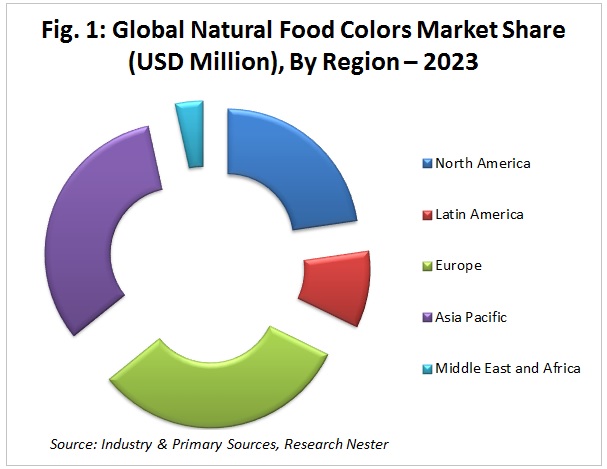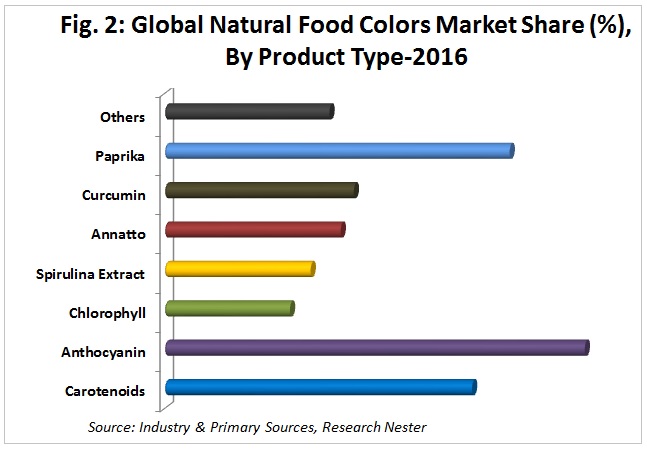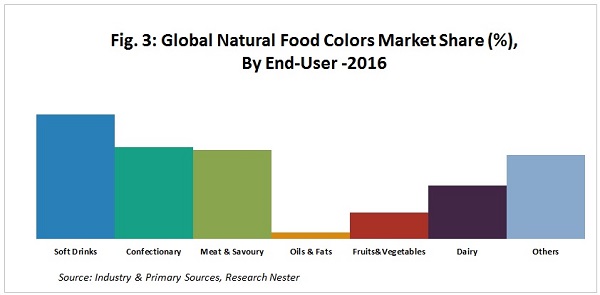Credible Factors augmenting the growth of the Global Natural Food Colors Market
- Naturex, a global botanical company dealing in plant-based natural ingredients, is highly investing in research & development and marketing & advertisement in order to develop and sale innovative products.
- The acquisition of Delta Aromatic and Teawolf by Dohler Group played a major role as the production and service hub for the dynamic markets in Africa, Middle East and North American region.
Market Overview
Government banned trading of synthetic colors in several regions such as Europe and Japan that has resulted in restricted manufacturing of the synthetic colors. This factor intensified the demand for natural food colors in various end-use industries. Several initiatives and promotions are carried out by various authorities in order to grow awareness towards eco-friendly and healthy natural food colors which are believed to exhibit a positive impact on the market of natural food colors by reaching USD 1,657.7 Million by the end of 2023 from USD 1,126.5 Million in 2016.
Moreover, technological advancements in food industries to procure sustainable solutions for the enhancement of packaged food are fostering the growth of the natural food colors market around the globe. Factors such as emergence of food industries owing to rising population and their daily need for food along with rising awareness among the population regarding the advantages of natural food colors and growing number of food products are estimated to expand the global natural food colors market with a CAGR of 5.8% over the forecast period 2018-2023.
Regional Growth Highlights during 2016–2023
The global natural food colors market is segmented by regions into North America, Latin America, Europe, Asia-Pacific and Middle East and Africa. Among these regions, Asia Pacific dominated the global natural food colors market by contributing a market share of 31.2% in 2016. The market of natural food colors is majorly driven on the back of stringent regulations by the government authorities on the manufacturing of synthetic food colors and rising awareness among the population regarding the benefits of natural food colors. Additionally, rising number of food industries and offering of new food products are likely to spur the demand for natural food colors in this region over the forecast period.
Europe & North-America natural food colors market size is projected to cross USD 900 Million by the end of 2023. Increasing awareness about the harmful effects of synthetic colors and the chemical used in manufacturing of such colors are substantially raising the demand for natural food colors in numerous end-use industries. Further, Europe market is expected to showcase a tremendous growth over the forecast period i.e. 2018-2023 by registering a CAGR of 6.1% over the forecast period and is expected to account for around USD 520 Million by 2023.

Get more information on this report: Download Sample PDF
Market Segmentation Synopsis
By Product
The global natural food colors market has been segmented by product into carotenoids, anthocyanin, chlorophyll, spirulina extract, annatto, curcumin, paprika and others. The demand for anthocyanin and paprika is estimated to remain dominant across the globe and these two types are projected to expand at a CAGR of 6.3% & 5.2% respectively during 2018-2023. On the other hand, curcumin accounted for around 10% of the total market share during 2016 and is believed to behold its positive stance in upcoming years. Further, the curcumin segment is expected to observe the growth rate of 1.4x over the forecast period and is expected to grow at a CAGR of 4.5% over the period 2018-2023.

By End-User
The global natural food colors market is divided by end-users into soft drinks, confectionary, meat & savoury, oil and fats, fruits and vegetables, dairy and others, out of which, the soft drinks segment dominated the overall market by holding around 26% of the market share in 2016 and is believed to dominate the market by reaching highest market size by the end of 2023. After the soft drinks segment, the second highest share holder of the global natural food colors market is confectionary segment, closely trailed by the meat & savoury segment. Further, the meat and savoury segment is estimated to witness a CAGR of 5.8% over the period 2018-2023.

By Application
The global natural food colors market is segmented by application into food & beverages, pet food, carbonated soft drinks and others. The demand for food and beverages is expected to dominate the application segment and is anticipated to have a share of more than 4o% in 2023. The second largest segment in the application segment is carbonated soft drinks followed by other alcoholic and non-alcoholic beverages segment. Further, the pet food segment is estimated to grow significantly by growing at a highest CAGR of 5.7% and is expected to observe the growth rate of 1.5x over the forecast period.
The study further analysis the Y-O-Y Growth, demand & supply and forecast future opportunity in North America (United States, Canada), Latin America (Brazil, Mexico, Argentina, Rest of LATAM), Europe (U.K., Germany, France, Italy, Spain, Hungary, BENELUX (Belgium, Netherlands, Luxembourg), NORDIC (Norway, Denmark, Sweden, Finland), Poland, Russia, Rest of Europe), Asia-Pacific (China, India, Japan, South Korea, Malaysia, Indonesia, Taiwan, Hong Kong, Australia, New Zealand, Rest of Asia-Pacific), Middle East and Africa (Israel, GCC (Saudi Arabia, UAE, Bahrain, Kuwait, Qatar, Oman), North Africa, South Africa, Rest of Middle East and Africa).
Market Drivers & Challenges
Growth Indicators
The global natural food colors market is riding on the back of the growing usage of natural food colors to make food more attractive, appealing, appetizing and informative. To provide color to colorless and ‘fun’ foods, the food and beverage industries are increasingly using natural food coloring which is expected to propel the market of natural food colors in upcoming years. In addition to that, certain food colorings allow consumers to identify products on sight, like candy flavors or medicine dosages. Besides, industries are trying to enhance colors naturally by using natural food colorings which is increasing the number of food and beverage industries across the globe.
Additionally, the demand for natural and chemical free colorings in organic food products is predicted to increase on the back of worldwide increase of food and beverage industries that is further believed to aid the global natural food colors market to grow in near future.
Barriers
There are some naturally occurring food colorings that are permanently banned due to their allergic reactions or toxin contaminations. Further, the cost, availability and sustainability of natural food colorings are some of the factors that might dampen the growth of the global natural food colorings market over the forecast period.
Top Featured Companies Dominating The Market
Some of the affluent industry leaders in the global natural food colors market are GNT International, ITC, Chr. Hansen Holding A/S, Kalsec Inc., Naturex, Sensient Flavors, ROHA Dyechem and Dohler Group.
Moreover, other key and niche players are investing highly in research and development activities to expand their product line offering which in-turn will help the company to get a stronger grip over the market in order to gain competitive edge in the global natural food colors market.

